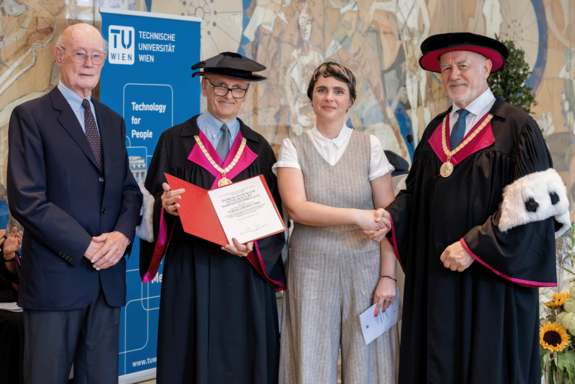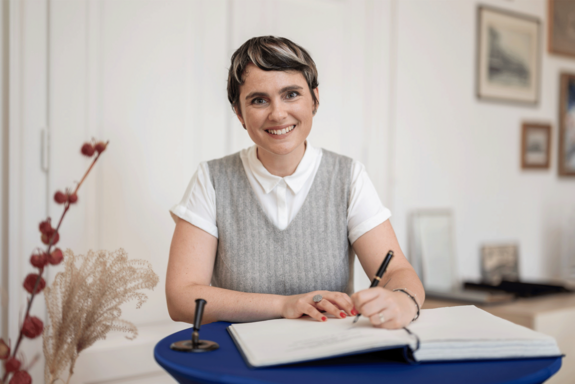Teresa Liberto was awarded the Andreas Dieberger – Peter Skalicky Science Prize 2023, endowed with 10,000 euros, in the Boecklsaal of the TU Vienna on September 18. This prize, donated by Margret Dieberger, aims to support TUW scientists in their habilitation phase. Rector Sabine Seidler welcomed the audience, which included former TUW-Rector Peter Skalicky and members of the Andreas Dieberger – Peter Skalicky Scholarship Foundation: TUW-Vice Rector Josef Eberhardsteiner, Herbert Hochegger, and Johannes Fröhlich, Vice Rector Research and Innovation, who held the laudatory speech for award winner Teresa Liberto. Her research is advancing the world's most common building material – cement – in the direction of CO2-friendliness.
Rheology – or the study of fresh behavior of complex pastes
"Panta rhei", everything flows, is a famous saying by the philosopher Heraclitus, which states that the world is in a perpetual flow of creation and decay. Teresa Liberto makes the leap from philosophy to the harsh reality of cement with the help of rheology, the science that studies the deformation and flow of matter. Liberto uses it to investigate low-CO2 binders, selecting the most promising ones for further solid-state mechanical analysis.
In the interview, the trained chemical engineer, who was born in Tuscany in 1989, says that she was inspired to study material science by her father, a craftsman, who selected the best product for each problem with care and know-how. She says she has always been curious to find out what materials products are made of, how they work, and how they evolved over time. Building materials and cement in general lent themselves perfectly to such an interest, Liberto said. Because of their complexity, she would never get bored with them.
For her, it's important to contribute to building a more sustainable society and, in turn, to the well-being of all humanity. "I envision a better future where my family can thrive without the constant challenges of the climate crisis." We asked Teresa Liberto some questions about concrete as a building material and her research:
How can concrete become CO2-neutral, and how difficult is it to achieve this goal?
Teresa Liberto: Nowadays circa 4 billion tons of cement are produced every year all around the world. In the quest for CO2 neutrality in construction, it is important to acknowledge that there is no miraculous remedy or groundbreaking zero-emission material readily available in this huge quantity. If we look back to the past, building materials were not standardized but rather local, which enabled the construction of extraordinary buildings that still exist today. With the technology of the present, and thanks to concrete, we can achieve high performance that is not, however, required for every single application. For the future, I think we should look to the past with the knowledge of the present, differentiating building materials used according to their application. For example, rediscovering alternative binders that are locally produced or are waste materials (e.g., industrial by-products) for low-load applications (e.g., individual houses) and high-performance materials (e.g., cement) for high-load applications (e.g., bridges). In other words, trying to avoid shipping raw materials from one side of the planet to the other. This approach will only work if, in parallel, standards and regulations are established for alternative binders that take into account different applications and CO2 impact. In addition, future civil engineers and construction workers should be trained on the different properties and applications of classic and alternative cementitious materials for their more sustainable use.
What stage has research reached in the field of CO2-neutral concrete and what is your contribution to it?
Teresa Liberto: The research in the field of CO2-neutral concrete has expanded in recent decades. There are many fields of research that should work in synergy to develop more sustainable and environmentally friendly concrete production methods. I mention only a few examples such as
- trying to capture the CO2 from industrial processes and using it as a binder/filler in concrete,
- reducing the energy consumption to produce cement,
- using recycled aggregates from construction and demolition wastes,
- substituting cement with alternative local/waste materials partially or totally.
The latter is my specific field of research. I focus in particular on detecting the early reactivity of alternative fresh formulations (hours) to select the promising ones for further mechanical analysis (minimum 28 days).
In this picture the industry plays a fundamental role in funding the research, giving input on the ongoing challenges, and creating, together with governments, new regulations and standards that encourage or mandate the use of low-CO2 concrete.
Do you believe that mankind will manage to become climate-neutral by 2040 or 2050, and what do you think the path to this goal looks like – in the context of the construction sector?
Teresa Liberto: I personally think that 2040/50 to achieve climate neutrality is ambitious given the little progress made in recent decades. But Humankind is sometimes capable of great strides in difficult times. Let's hope we don't act too late.
As reported by CEMBUREU, opens an external URL in a new window (the European Cement Association), a road map to reduce emissions in the construction sector to zero (by 2050) already exists and consists of simultaneous actions, from alternative fuels for cement production to the replacement of cement itself. As mentioned earlier, there is not one single solution, but rather a set of them that should be selected depending on where we are in the world and what materials are readily accessible. As my university professor used to reply to questions "It depends"! Especially in densely populated areas where there is already a network of infrastructure (bridges, buildings, etc.) proper maintenance is essential, and a reuse at the end of their life. For example, recycling demolition materials to build new structures on-site is an important solution to reduce the environmental costs of raw materials. Of course, the feasibility of the reuse depends on how the buildings were made and how they have been renovated over the years (compatibility of materials, separability...). Therefore, it is important to design new buildings and construction sites with a reuse rationale and to use, where possible, locally available materials suitable for the required performance.
CV Teresa Liberto
Teresa Liberto was born in 1989 in a village between Pisa and Florence, in the heart of Tuscany. Between 2011 and 2014 she obtained her Bachelor's and Master's degrees from the University of Pisa in Chemical Engineering. In 2014, she followed a three-month study visit to the City College of New York for her Master's thesis; in 2015–2018, she completed her PhD in Physics at Université Claude Bernard Lyon 1, which was part of the European project "NanoHeal" on low CO2 concrete, in which she worked on the physicochemical study of dense limestone suspensions. In 2019, she took up her postdoctoral position at TU Wien, in the Building Materials Research Unit at the Faculty of Civil and Environmental Engineering, where she started to explore the complex world of "real" cementitious pastes (cement, slag, calcined clay, recycled cement...). Since September 2019, Liberto has held a tenure-track position in Sustainable Cementitious Materials at the Department of Civil and Environmental Engineering in the research unit of Building Materials (E207-1). In March 2023, she initiated the process to obtain her habilitation (i.e., venia docendi) in the field of material science for binders.
Link: Dieberger-Skalicky Science Award
Article and interview: Edith Wildmann

